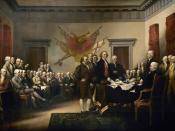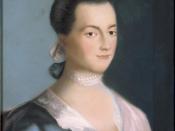In a lively and engaging narrative, author Joseph J. Ellis describes in his novel, "Founding Brothers," the sometimes collaborative, and sometimes clashing interactions between the founding fathers, and shows us the private characters underneath their public personas: Adams, the ever-combative image breaker, whose closest political collaborator was his wife, Abigail; Burr, cunning, suave, and one of the most detested public figures of his time; Hamilton, whose fearless manner and deep economic discernment cloaked his modest origins; Jefferson, famous for his eloquence, but so reclusive that he rarely spoke more than a few sentences in public; Madison, small, sickly, and painfully shy, yet one of the most effective debaters of his generation; and the strongly formal Washington, the ultimate realist and America's truly essential figure.
During the 1790s, which Ellis calls the most decisive decade in our nation's history, the founding fathers came together to define the new republic and direct its course for the coming centuries.
Ellis examines closely six distinct moments that illustrate the most crucial issues facing the frail new nation: Burr and Hamilton's deadly duel, and what may have really happened; Hamilton, Jefferson, and Madison's secret dinner, during which the seat of the permanent capital was determined in exchange for passage of Hamilton's financial plan; Franklin's petition to end the "peculiar institution" of slavery--his last public act--and Madison's efforts to quash it; Washington's precedent-setting Farewell Address, declaring his retirement from public office and offering his country some final advice; Adams's difficult term as Washington's replacement and his so-called scheme to hand the presidency on to his son; and finally, Adams and Jefferson's renewed agreement, in which they compared their different views of the Revolution and its legacy.
Ellis presents the American Revolution in six short stories. This structure allows the reader to enjoy American History without...


